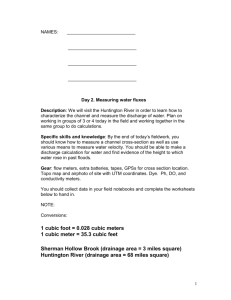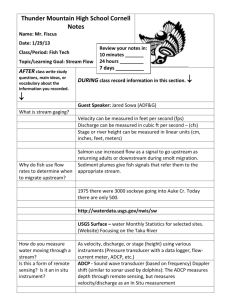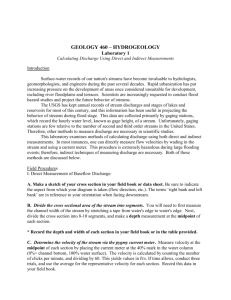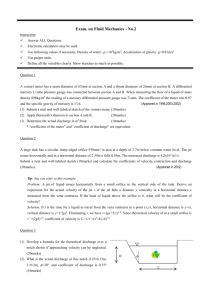GEOLOGY 460 – HYDROGEOLOGY
advertisement
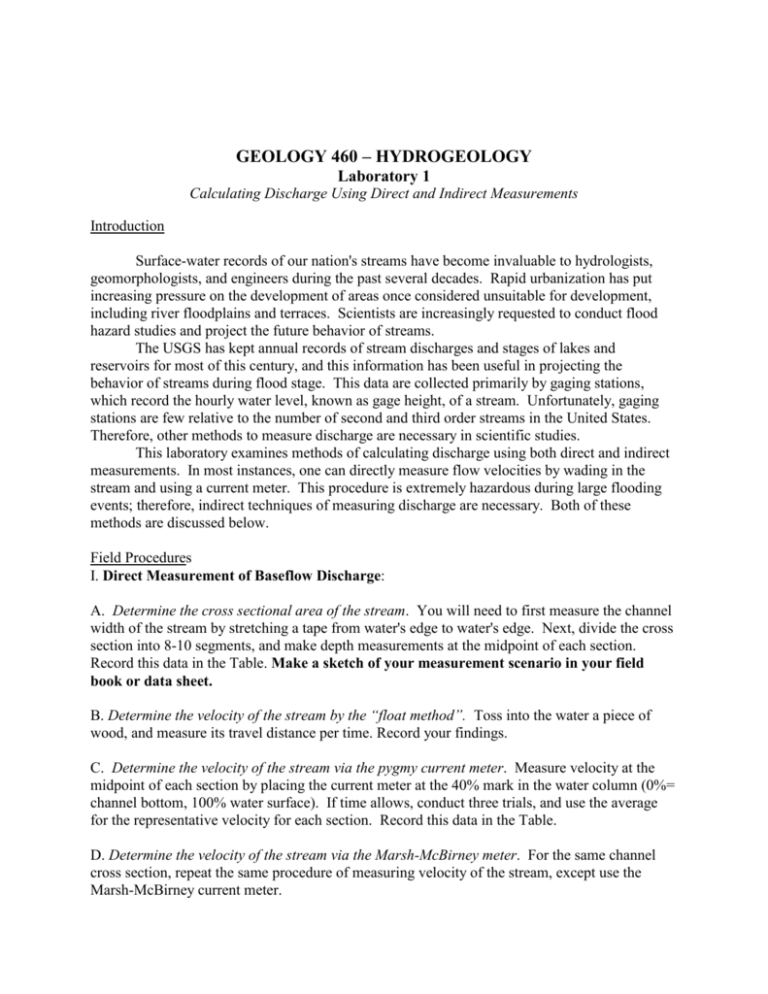
GEOLOGY 460 – HYDROGEOLOGY Laboratory 1 Calculating Discharge Using Direct and Indirect Measurements Introduction Surface-water records of our nation's streams have become invaluable to hydrologists, geomorphologists, and engineers during the past several decades. Rapid urbanization has put increasing pressure on the development of areas once considered unsuitable for development, including river floodplains and terraces. Scientists are increasingly requested to conduct flood hazard studies and project the future behavior of streams. The USGS has kept annual records of stream discharges and stages of lakes and reservoirs for most of this century, and this information has been useful in projecting the behavior of streams during flood stage. This data are collected primarily by gaging stations, which record the hourly water level, known as gage height, of a stream. Unfortunately, gaging stations are few relative to the number of second and third order streams in the United States. Therefore, other methods to measure discharge are necessary in scientific studies. This laboratory examines methods of calculating discharge using both direct and indirect measurements. In most instances, one can directly measure flow velocities by wading in the stream and using a current meter. This procedure is extremely hazardous during large flooding events; therefore, indirect techniques of measuring discharge are necessary. Both of these methods are discussed below. Field Procedures I. Direct Measurement of Baseflow Discharge: A. Determine the cross sectional area of the stream. You will need to first measure the channel width of the stream by stretching a tape from water's edge to water's edge. Next, divide the cross section into 8-10 segments, and make depth measurements at the midpoint of each section. Record this data in the Table. Make a sketch of your measurement scenario in your field book or data sheet. B. Determine the velocity of the stream by the “float method”. Toss into the water a piece of wood, and measure its travel distance per time. Record your findings. C. Determine the velocity of the stream via the pygmy current meter. Measure velocity at the midpoint of each section by placing the current meter at the 40% mark in the water column (0%= channel bottom, 100% water surface). If time allows, conduct three trials, and use the average for the representative velocity for each section. Record this data in the Table. D. Determine the velocity of the stream via the Marsh-McBirney meter. For the same channel cross section, repeat the same procedure of measuring velocity of the stream, except use the Marsh-McBirney current meter. II. Indirect Measurement of Baseflow Discharge: One method of indirect measurements of discharge uses the Manning Equation, given as: Q = A R2/3 S 1/2 N-1 where: Q = discharge (volume/time) S = slope (decimal) A = area of channel (area) N = roughness of channel (non dimensional) R = hydraulic radius (length), where R = area / wetted perimeter, where Wetted perimeter = depth left bank + depth right bank + bottom width Determine the slope of the channel bottom using the clinometer. Have a lab partner of equal height stand at the water's edge 30-50 m upstream of your position, which is also at the water's edge. Looking through the clinometer, sight on your lab partner at their eye level. Record the value of slope in percent. Be sure to convert to decimal form when using the Manning Equation. Make observations concerning the size and distribution of the sediment supply in the stream channel. Use this data to estimate Mannings roughness value. Use your previous direct measurements of discharge to calculate the wetted perimeter and hydraulic radius. Analysis of Data: 1. To calculate the baseflow discharge using direct methods, draw the channel cross section on graph paper or using a computer graphing program. Do not exaggerate the vertical scale. Calculate the area of each section by using your field measurements. Using the velocity measurements, determine the discharge passing through each cross sectional area. Calculate the total discharge, Qt, by summing the discharges in each section using the following equation: Qt = A1V1 + A2V2 + A3V3 + ....AnVn 2. Using indirect methods, baseflow discharge is calculated by the Manning Equation as outlined in the previous section. Questions to Ponder and Answer (you may come and ask me for help, if needed) 1. Compare the values of velocity for the pygmy meter versus the Marsh-McBirney meter. As a whole, are the values similar or different? What factors may account for these differences? 2. Compare the discharge of the upstream section versus the downstream section. How do they compare? What factors may account for these differences? 3. You made observations of the bed material, which is used to estimate the Mannings roughness coefficient. Using your direct measurement of flow data, “back out” the value of Mannings roughness coefficient using the Manning Equation. 4. Consider the flow conditions observed today in the stream. Based on your observations, do you think overland flow is a major component of the total flow observed today? Why or why not? Suggest a way that you could crudely separate components of baseflow and overland flow in the stream over the course of the last several weeks. Include what information is needed, and where you would seek out the required data. The Final Product: Introduction (why are we getting wet? Give the reason/purpose of the lab) Methods and Materials (you want to be able to recreate the technique in 5 years when you are teaching as a graduate assistant) Results (including data tables, etc.) Discussion (this is where you make your interpretations, and address the posed questions listed above) Concluding remarks Due Date: Wednesday, September 15, beginning of class. Upper Reach or Lower Reach (circle one) Channel Slope: ______ Size of Bedload:_______ Estimation of Q using “float method”_______ Pygmy meter Section # Channel Width Channel Depth Current Meter Reading Discharge Marsh-McBirney meter Section # Channel Width Channel Depth Current Meter Reading Discharge 1 2 3 4 5 6 7 8 9 10 11 1 2 3 4 5 6 7 8 9 10 11


